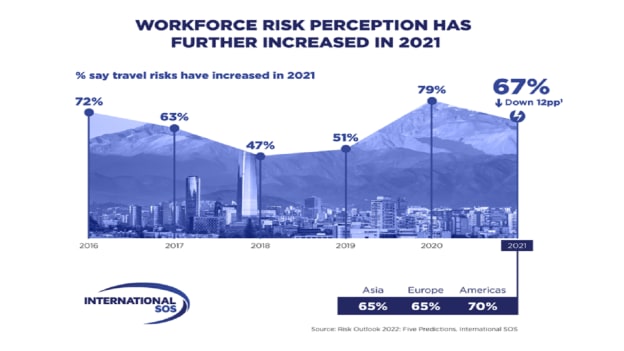A lowdown on the global risk outlook for work in 2022

How does the global risk outlook for 2022 look like? Data from International SOS Risk Outlook 2022 Survey reveals that workforce risk perception has further increased in 2021.
The report outlines the following top five expected causes of employee productivity decreases in 2022-
- COVID-19
- Mental health issues
- Natural disasters including extreme weather
- Transport concerns
- Security threats and civil unrest
No surprise here-for many organisations COVID-19 will continue to be a significant operational challenge. A third (33%) of respondents said that having adequate resources to deal with the virus was a top challenge for 2022.
While the pandemic tops the lists of concerns, other perennial security risks are expected to cause disruption in 2022. With concern growing over climate change, 21% of respondents predicted that natural disasters including extreme weather would be disruptive in 2022. This was closely followed by transport concerns – for local, domestic and international travel – (19%) and security threats and civil unrest (16%).

So how will organisations respond?
The survey of nearly 1,000 risk professionals across 75 countries, coupled with insight from the Workforce Resilience Council and International SOS proprietary data, indicates that both mental and physical health support will see increased investment. In fact, over half (56%) of organisations intend to increase spending on both.
The need for increased investment comes as organisations expect to face increased risks in 2022. Over two thirds (68%) of organisations anticipate risks to increase or stay the same next year. In particular, decision makers responsible for business travel (69%) and international assignees (67%) expect risk levels to increase or stay the same in 2022.
In response, organisations must identify internal and external crisis management blind spots and act now to make effective decisions and strengthen their resilience. They must keep travelling staff, as well as domestic workforces, reliably informed. Staying on top of regulatory changes will also be critical, making sure that they have the right processes in place to fulfil Duty of Care obligations.
Here’s what you can expect in 2022 as per International SOS
Based on the findings of the Risk Outlook survey, the Workforce Resilience Council and the organisation’s proprietary data, International SOS’ top five predictions for next year are:
- COVID-19, Long COVID, & mental health will be primary employee productivity disruptors.
- The infodemic will continue to exacerbate the complex nature of protecting people, while Duty of Care obligations are reshaped by new health & safety measures, employee expectations, & regulatory compliance.
- Pandemic-disrupted activities will reach a degree of stability by 2023, as organisations utilise health & security risk management as a competitive advantage: supporting employee retention, and willingness to return to activities incl. business travel.
- Organisations risk being caught off-guard by rapidly changing security environments, as civil disorder and geopolitical volatility will rise above pre-pandemic levels.
- Climate change will increase the frequency and impact of climate-sensitive hazards, such as infectious diseases, extreme weather events, and socioeconomic tensions
In short, organisations need to stay on top of current and emerging health & wellness challenges and invest in both emotional health and physical wellness support for employee retention and fighting off risks to productivity.

















